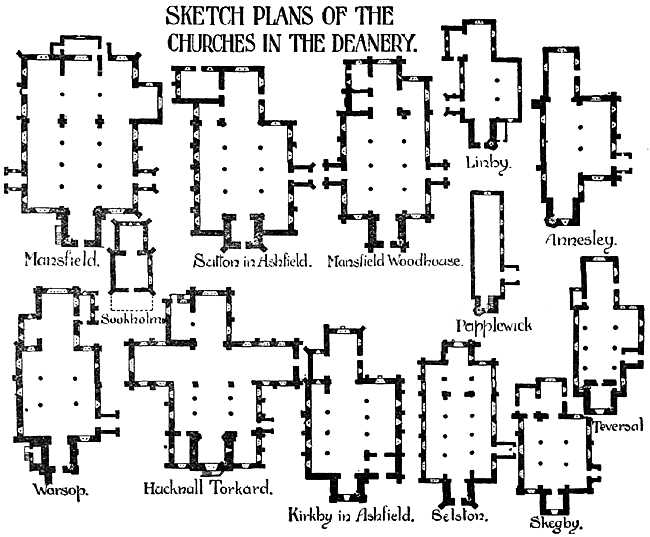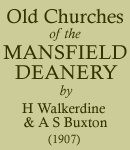< Previous | Contents | Next >
Introduction

DURING the next few weeks we propose to publish a series of articles descriptive of the churches in the Mansfield Deanery. Notts, churches have not received the attention they deserve from the historian. With the exception of Godfrey's "Churches of Broxtowe," there are few works dealing with the interesting and architecturally beautiful edifices in the county. The clergy in some instance have collected data for brochures of the churches they are or were associated with, but, generally speaking, the subject has been neglected. We have nothing in Notts, like Dr. Cox's monumental work of the churches of Derbyshire. It therefore appears fitting that this series of articles, compiled with care, and illustrated by a number of sketches far above the average found in newspaper work should be published, and through the columns of one of the oldest weekly papers in the county. The writers— there are two—have spared no pains to make the articles complete. They will appeal not only to the ordinary newspaper reader, but the antiquarian will find much in them that will interest him. The architectural features of the buildings have been very carefully noted, and the information will be found valuable, especially in regard to the ruined church of Kirkby-in-Ashfield, where many traces of bygone days were destroyed by the recent fire. Some particulars of the old bells removed from the ancient church at Annesley and placed in the new edifice, but destroyed by fire the evening succeeding the conflagration in the neighbouring parish, are also interesting. Every belfry in the Deanery has been visited and items of camponological interest connoted. The ancient registers of no church have been overlooked, and many facts which throw light upon the times in which they were written, have been extracted. Unfortunately there are but few instances of churchwardens' accounts being preserved. Where they are extant some amusing extracts have been made from them. Information for the articles has been obtained from many sources. The descriptive work is from the writers' personal observations, but historical facts have been collected from the county historians, including Thoroton, Bailey's Annals, and Harrod's History of Mansfield, the National Biography, the Pipe, and other rolls, the manucripts at the British Museum, the Archbishop of Canterbury's library at Lambeth Palace, with its wealth of Cromwellian MS., the Torre Manuscript at York, and the Public Record Office, to name the most important. We desire to acknowledge the value of the Rev. R. J. King's parish history of Warsop, and Canon Prior's admirable book on the parish church of Mansfield, for many of the facts contained therein have saved us the somewhat tedious process of going through registers, often badly written and partly obliterated, and other documents. At Lambeth Palace Library we extracted, from the originals, the augmentation lists applying to a number of the churches, and the 1650 surveys, which contain information about the churches of Mansfield, Skegby, Mansfield Woodbouse, Sutton, Kirkby, Teversal, Selston, Hucknall, Linby, Warsop, and Papplewick were also seen. The 1552 inventory will be dealt with in a separate article, and there will also be a column of interesting matter dealing with the bell founders' marks on the bells as well as illustrations of the ornament and lettering found. Churches bearing evidence of Norman foundation are Teversal, Mansfield, Warsop, Sutton, Kirkby, Mansfield Wood-house, Papplewick, Skegby, Linby, Selston, Annesley and Soulkholme. At Mansfield the Norman workmanship is to be found in the lower part of the tower; at Warsop it is also in the tower; Sutton, the nave arcade; Kirkby, also the nave arcade; the font at Mansfield Woodhouse; the chancel arch at Skegby (restored); at Linby the inner door of the porch and some church walling; Selston's north arcade; Annesley's font; Sonlk-holm's chancel arch and font; and Teversal's inner door and porch. The Early English period is traced at Hucknall Torkard in the tower, the north nave, arcade and chancel (since restored); at Teversal there is an Early English foundation, and the nave arcade, chancel and south chapel are good examples of the period; at Mansfield it is seen in the north aisle walling; at Warsop the south porch and aisle; Kirkby chancel arch, south arcade and tower arch; Skegby south arcade; Linby and Selston also the south arcades. At Mansfield we find the Transition, Early English and Decorated periods represented in the nave arcades, and the same is observed at Warsop. The most beautiful example of the Decorated style in the deanery is to be found in the Felly Chapel at Annesley. and the next in importance will be noticed at Mansfield Woodhouse in the tower and spire. Sutton and Papplewick have work of the same date in the tower, and the upper part of the tower at Mansfield is also Decorated. Odd windows of the period are to be found in several places. The Perpendicular period, which lasted so long, from 1377 practically to 1546, naturally left its mark upon the Deanery. The chancel chapels at Mansfield are tne most extensive examples, but perhaps the finest work is to be seen at Warsop. Here the handsome little vestry, built on the south side of the church, is of this date, and other traces of Perpendicular work are to be noticed in the towers at Linby. Selston, Teversal, and in the north aisle at Hucknall. There are many pieces of windows, walling, moulding, etc., to he seen up and down the Deanery of buildings dating to the time when'the Gothic revivial set in at the end of the 18th century. Papplewick presents an interesting specimen of the spirit in which Gothic was then built. Mansfield Woodhouse steeple is a fine example of the Northamptonshire type. It is not until we see the sketch which accompanies this introductory matter, that we realise the great difference that exists in the plans of the churches. It will be noticed that Hucknall is the only edifice in the Deanery which possesses transepts, and these are new, Mansfield alone has north and south chapels, and Warsop is the only church with a vestry on the south side. There are two aisleless churches, Papplewick and Soulkholme, and those possessing one aisle are Linby and Annesley. Mansfield Woodhouse originally had one only, as will be seen from the illustration which accompanies the article dealing with St. Edmund's, and another church that had but one aisle was Skegby. There are three churches which do not possess a projecting porch, and Soulkholme has no porch at all. To prevent repetition, we might here state what the Notitio Parochialis the augmentations, and the surveys are, all of which are housed in the Archbishop's library at Lambeth. The Notitia Parochialis is a collection of six volumes which contain 1,579 returns to queries of a now unknown divine. These returns were found at the bottom of a brief for the rebuilding of the church of All Saints' in Oxford, 1705. They were bound in volumes and deposited in Lambeth library by order of Archbishop Seeker, who, by the way, was a Nottinghamshire man. The questions proposed by the unknown person are so interesting and have produced so many important answers that the present keeper of the records considers it a notification well worthy the attention of the clergy in copying them. The only churches in the Deanery mentioned in these answers are Linby, Selston, Hucknall and Mansfield. We might give the " advertisement " as the queries are called. It is as follows: "To the Reverend the minister of every parochial church or chapel in England. There being a design formed of publishing the present state of every parish church giving an account of all persons who have been benefactors to the church since the Reformation . . . asking for return of particulars as to tithes augumentation, what union or dismembering, if any, what library is settled in your parish. If the yearly value of your rectory vicarage or chapelry be under £30, how much and to whom does the advowson belong." In the introduction to the Parliamentary surveys, we read that they were made in pursuance of various ordinances of Parliament, during the Commonwealth by surveyors appointed for that purpose, acting on oath under instructions given to them as may be seen in Scobells Acts and Ordinances 1649. The original surveys were returned to the Registrar appointed by the ordinances and duplicates of transactions, and they were transferred to the trustees or commissioners nominated who held their meetings in Broad-street in the city, where they remained until after the Restoration. On the 6th August, 1660, the House of Commons having received information that these documents were in the keeping of William and — Ayloffe ordered their return. It was in consequence of this and a similar order that these valuable records were delivered to Archbishop Juxon, and were deposited at Lambeth library. The augmentation of livings dating from the year 1647-58 also were delivered over by an order of the House of Commons to Archbishop Juxon, in 1662, to be preserved at Lambeth. These records relate to church property during that period and form a sequel to the Parliamentary surveys. They contain varied information as to property, tithes, etc., in the Commonwealth period, many particulars of tenure, parish boundaries, names of ministers, also items regarding religion, foundations, hospitals, schools, and other institutions.
